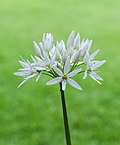Allium ursinum
Allium ursinum, commonly known as wild garlic, bear's garlic, or ramsons, is a perennial flowering plant in the family Amaryllidaceae. It is native to Europe and Asia, where it grows in moist woodland areas, often forming extensive carpets on the forest floor.
Description[edit]
Allium ursinum is a bulbous, herbaceous perennial plant. It typically grows to a height of 20–50 cm. The plant has broad, lanceolate leaves that are 10–25 cm long and 2–5 cm wide. The leaves are similar in appearance to those of the Lily of the Valley, but can be distinguished by their strong garlic odor.
The plant produces a flowering stem, or scape, which bears a spherical umbel of white flowers. Each flower is star-shaped, with six tepals, and measures about 1–2 cm across. The flowers bloom in late spring, typically from April to June.
Habitat and Distribution[edit]
Allium ursinum is found throughout Europe and parts of Asia. It thrives in damp, deciduous woodlands, often in shaded areas with rich, moist soil. The plant is commonly found in the understory of beech and oak forests.
Uses[edit]
The leaves of Allium ursinum are edible and have been used in cooking for centuries. They have a mild garlic flavor and can be used in salads, soups, and sauces. The leaves are often harvested in the spring before the plant flowers.
In addition to its culinary uses, Allium ursinum has been used in traditional medicine. It is believed to have antibacterial and antifungal properties, and has been used to treat various ailments, including digestive disorders and high blood pressure.
Ecology[edit]
Allium ursinum plays an important role in its ecosystem. It is a source of food for various insects, including bees and butterflies, which are attracted to its flowers. The plant also provides habitat and cover for small woodland animals.
Related Species[edit]
Allium ursinum is closely related to other members of the Allium genus, including Allium sativum (common garlic) and Allium cepa (onion). These species share similar characteristics, such as bulbous growth and a strong odor.
Gallery[edit]
-
Allium ursinum
-
Allium ursinum
-
Allium ursinum
-
Allium ursinum
-
Allium ursinum
-
Allium ursinum
-
Allium ursinum
-
Allium ursinum
-
Allium ursinum
-
Allium ursinum
-
Allium ursinum
-
Allium ursinum
Related Pages[edit]
Ad. Transform your life with W8MD's Budget GLP-1 injections from $75


W8MD offers a medical weight loss program to lose weight in Philadelphia. Our physician-supervised medical weight loss provides:
- Weight loss injections in NYC (generic and brand names):
- Zepbound / Mounjaro, Wegovy / Ozempic, Saxenda
- Most insurances accepted or discounted self-pay rates. We will obtain insurance prior authorizations if needed.
- Generic GLP1 weight loss injections from $75 for the starting dose.
- Also offer prescription weight loss medications including Phentermine, Qsymia, Diethylpropion, Contrave etc.
NYC weight loss doctor appointmentsNYC weight loss doctor appointments
Start your NYC weight loss journey today at our NYC medical weight loss and Philadelphia medical weight loss clinics.
- Call 718-946-5500 to lose weight in NYC or for medical weight loss in Philadelphia 215-676-2334.
- Tags:NYC medical weight loss, Philadelphia lose weight Zepbound NYC, Budget GLP1 weight loss injections, Wegovy Philadelphia, Wegovy NYC, Philadelphia medical weight loss, Brookly weight loss and Wegovy NYC
|
WikiMD's Wellness Encyclopedia |
| Let Food Be Thy Medicine Medicine Thy Food - Hippocrates |
Medical Disclaimer: WikiMD is not a substitute for professional medical advice. The information on WikiMD is provided as an information resource only, may be incorrect, outdated or misleading, and is not to be used or relied on for any diagnostic or treatment purposes. Please consult your health care provider before making any healthcare decisions or for guidance about a specific medical condition. WikiMD expressly disclaims responsibility, and shall have no liability, for any damages, loss, injury, or liability whatsoever suffered as a result of your reliance on the information contained in this site. By visiting this site you agree to the foregoing terms and conditions, which may from time to time be changed or supplemented by WikiMD. If you do not agree to the foregoing terms and conditions, you should not enter or use this site. See full disclaimer.
Credits:Most images are courtesy of Wikimedia commons, and templates, categories Wikipedia, licensed under CC BY SA or similar.
Translate this page: - East Asian
中文,
日本,
한국어,
South Asian
हिन्दी,
தமிழ்,
తెలుగు,
Urdu,
ಕನ್ನಡ,
Southeast Asian
Indonesian,
Vietnamese,
Thai,
မြန်မာဘာသာ,
বাংলা
European
español,
Deutsch,
français,
Greek,
português do Brasil,
polski,
română,
русский,
Nederlands,
norsk,
svenska,
suomi,
Italian
Middle Eastern & African
عربى,
Turkish,
Persian,
Hebrew,
Afrikaans,
isiZulu,
Kiswahili,
Other
Bulgarian,
Hungarian,
Czech,
Swedish,
മലയാളം,
मराठी,
ਪੰਜਾਬੀ,
ગુજરાતી,
Portuguese,
Ukrainian











